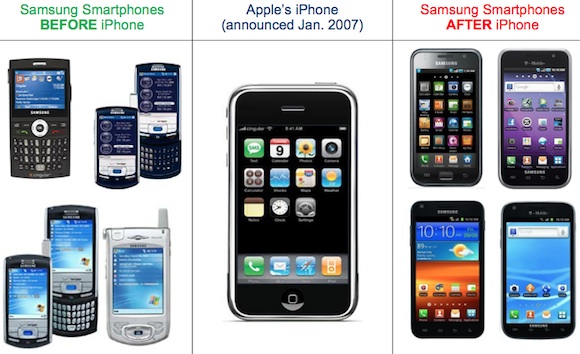There’s an old saw in consumer electronics that goes something like this: if Palm/Google/Samsung/LG/Huawei/RIM wants to compete with Apple, why don’t they hire a bunch of great people, lock them in a room, give them millions of dollars, and make them build a great phone. They can’t come out until they’re done.
Don’t believe this is true? Check out the 132 page document released during the Apple v. Samsung trial that’s making the rounds right now. It proves two things: that the iPhone was top of mind for Samsung designers and engineers and, more important, there was a group of people dedicated to figuring out what it took to make a best-selling phone. Whether they succeeded or not is a matter of debate – the Galaxy line is doing quite well – but the document shows us exactly how Samsung reacted to the iPhone.
The document is exactly what Samsung needed to do in reaction to the iPhone, but many would argue that their efforts were aimed at copying rather than innovating. Samsung is a leader in Android phones for a few primary reasons – this document is one of them – and it made perfect business sense.
CE designers are in the business of making phone after phone. If you’re confused as to why Samsung just doesn’t shut down their assembly line and build a few great phones, it’s because, like content businesses and food service, you make money by making things. Notice I didn’t say selling things. You just need to release them. Of the number released, a percentage will sell, a percentage will be returned, and you can then discount the products and/or recycle them. It’s an endless loop predicated on very basic market variables.
Apple, however, interrupted that loop. They built something that was clearly very popular and was eviscerating phone sales. Nokia didn’t fail because people didn’t like phones anymore. They just didn’t like Nokias. RIM isn’t on the ropes because CEOs have moved away from email. It’s on the ropes because Apple ate their lunch.
The reaction? Well, some phone companies – Palm being the best example – put a bunch of folks into a room and built a phone. They spent a lot of money, pumped out a nice mobile OS, and then ran out of cash. Other companies like Microsoft embarrassed themselves for a little while and then redid their entire operating system from the ground-up, offending die-hards in the process but potentially remaking their business.
Samsung simply saw the competitor and copied it. Motorola used to be winning by making phones that were anti-iPhones. Samsung is winning now by making the iPhone. It’s working for them, and it will continue to work. They have the ability to make millions of units a year and sell the vast majority.
Again, a flat slab of dark glass does not an empire make. Apple didn’t invent the dark-obelisk-like design, they merely took it to its obvious conclusion. Samsung, blindsided by this upstart, did what huge corporations usually do: they yelled at their designers who, in turn, assessed what they were doing wrong and wrote a report on it. This report is living proof that Samsung was and is scared of the iPhone and, more important, they’d do anything to copy it.
How scared was Samsung? I remember a Samsung rep asking me before the launch of the first iPhone what I thought of a non-existent product. I gave him the standard laundry list of rumored specs I had heard over the months before and he, presumably, took them back to his team.
What Samsung ultimately did was take a bunch of people, lock them in a room, and yell at them. The result is the document below. It’s a reaction to perceived failure and it’s essentially a carefully worded mea culpa. As Mic Wright notes in Kernel, the company is a defining force in South Korea and failure of any stripe is not allowed. Does this mean Samsung needs to be singled out for copying the iPhone? No, but it does mean that Samsung tried its damnedest to make things right in its own myopic way.
